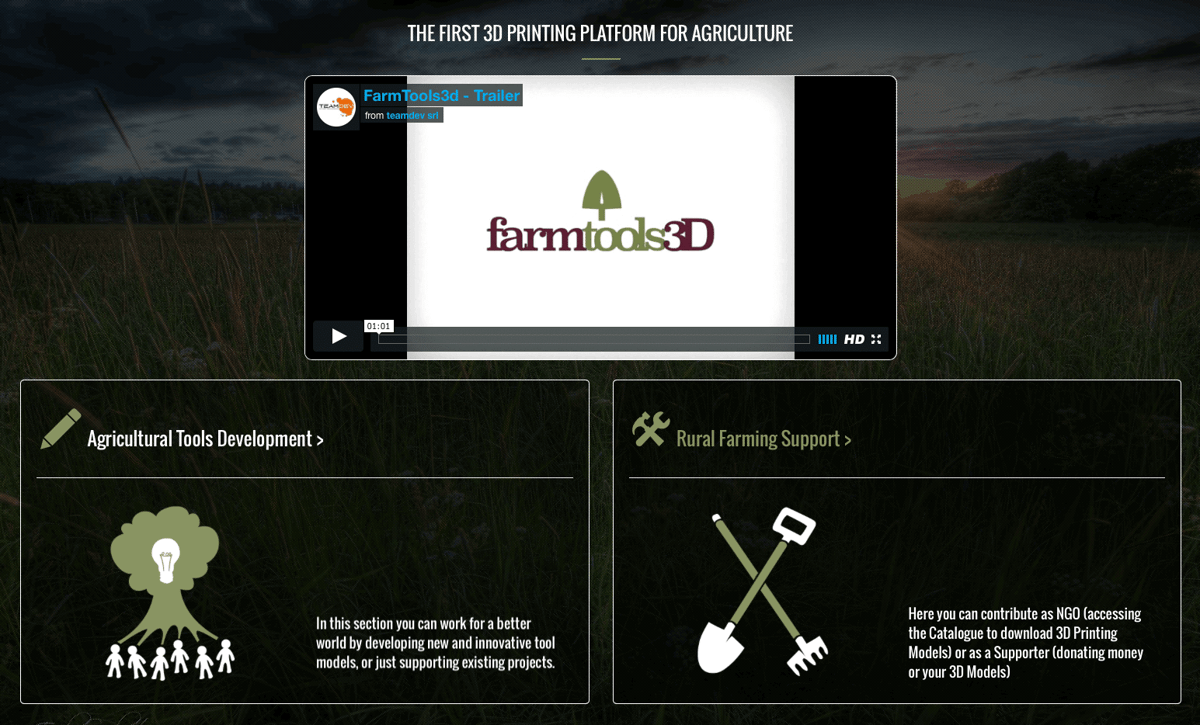Democratized, open source agriculture sounds like an unusual concept, but that’s exactly what FarmTools3D hopes to achieve with 3D printing.
The use of 3D printing to manufacture replacement parts that anyone can use, or fix and build useful objects, is possibly one of the true “killer applications” that will take the technology mainstream.
But the road is long, and along the way we’ll encounter fascinating projects like FarmTools3D, a collaborative platform that seeks to use accessible 3D printing technologies to improve agriculture all over the world.
The project was started by Andrea Cruciani and Alex Paiella as one of several other projects focusing on the idea of “precision farming”. Cruciani is the founder and CEO of TeamDev, a small software company located in the Umbria region of Italy.
Growing 3D Printing with FarmTools3D

“We have been literally overwhelmed by the response that some of these projects have received both from incubators and investors,” says Alex Paiella, EU project manger at TeamDev.
“We are going to be present at the Mobile World Congress in Barcelona for a project sponsored by the Telefonica mobile operator, and we have just attended the meeting in Bilbao for the FABulous European fund that financed FarmTools3D.”
The idea driving FarmTools 3D is that of a web platform that aims to provide a collaborative environment where makers and final users can share knowledge, provide feedback and 3D print farm tools for trials, or for even for actual everyday activities.
“It will be like a sort of virtual marketplace that will facilitate contacts and exchanges between all parties involved, to the benefit of many,” Alex Paiella continues. “We are now scheduled for a September commercial launch of the platform. and we are following all the steps of the FABulous financing process.”
In order to achieve its goal of driving production of next generation tools for agriculture, FarmTools3D combines a crowd funding and a crowd testing platform. These will enable Universities and other research institutions to compete for funding while, at the same time, relying on NGO’s for product testing an feedback. On the other hand, NGO’s will benefit from a wide range of free and easily accessibile 3D printable farm tool models.
Three Step Approach to Smart, Distributed Farming

Specifically, the first aspect is to promote rapid trials of new agricultural tools on the field, before they get into mass-production. One case study in this regard is the development of a new generation of insect traps.
“There are several kinds of insect traps for agriculture but the research for better trap designs generally proceeds very slowly,” says Paiella. “FarmTools 3D wants to become the reference crowdtesting platform for new kinds of tools that users can improve, 3D print and test on the field.”
The second aspect is the implementation of an accessible and farm-tool focused crowdfunding service, which will available to university research centers and makers worldwide in order to raise money for research activities.
The third and final aspect aspect is to provide agricultural tools to rural farming activities in developing nations, providing them with simple products (like a hose adapter or irrigation system components that can be 3D printed locally) and more sophisticated tools that can be 3D printed as prototypes and taken to local blacksmiths to reproduce the final versions.
A quick visit of FarmTools3D closed online beta revealed a stylish and accessible platform. From the homepage users can access two distinct main areas: Agricultural Tool Development and Rural Farming Support. The Tool development section leads to the crowdfunding and crowd testing campaigns (for customers) and projects (for proposers).
The Rural Farming section, on the other hand, leads to an online marketplace where users can already browse through several 3D printable tools. They can also chose to donate to an NGO, upload a model, and share it on social networks.
In the past few years, agriculture has become aware of how technologies can improve production and reduce costs (both economic and environmental). A great opportunity for smart agriculture can come from 3D printing technology and from the distributed intelligence of thousands of makers around the world.
Intensive mass-farming is rapidly destroying entire ecosystems: distributed, smart farming could help to save them.
https://vimeo.com/teamdev/farmtools3d
License: The text of "FarmTools3D uses 3D Printing to Bring Better Farming to All" by All3DP is licensed under a Creative Commons Attribution 4.0 International License.